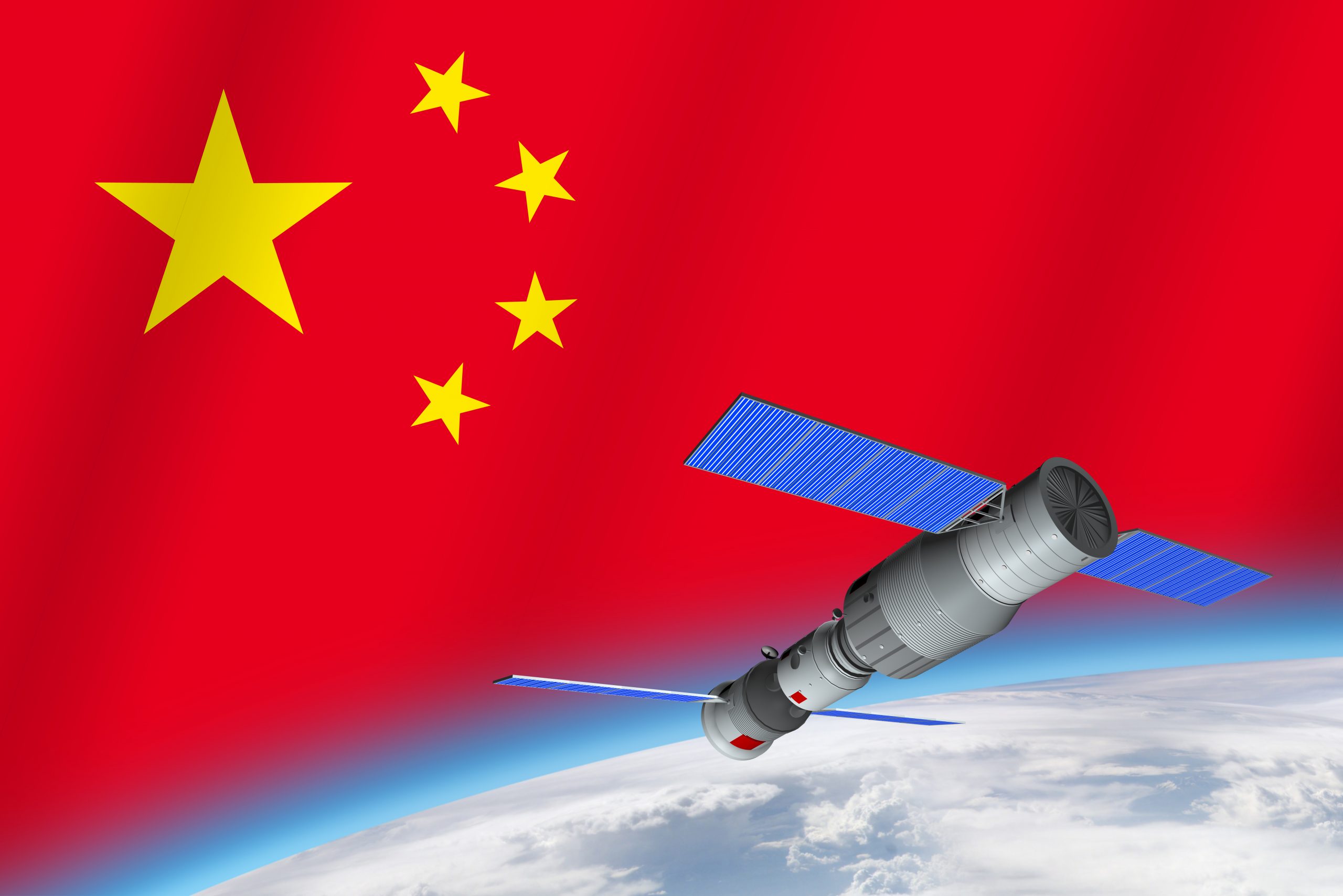
Watch Out for Space Capabilities of China
Wed, 10 Feb 2021 | Reading Time: 11 minutes

China’s showcasing of some microwave systems in the face-off with India in Ladakh has many analysts looking closely at China’s military capabilities. Change in administration in the United States has all eyes focussed at the future equation between the two great powers. One place that this powerplay is most evident is in the domain of Space. China’s meteoric rise in space technology has forced the USA to recommence the manned missions to the moon through its “Artemis” program. Every few days, China announces a new milestone in its exploration and exploitation of space. On September 06, 2020, China announced the first landing of a reusable space vehicle at Lop Nur. In June 2019, China became the third country to successfully launch an orbital space mission from a sea-based platform. A Long March 11 rocket carrying seven satellites blasted off from a large semi-submerged barge in the Yellow Sea. China’s second sea-based space launch placed 9 satellites in orbit on 15 September 2020. The flexibility afforded by sea launches will allow China to provide better commercial launch services for countries along the Belt and Road network. China is the third country to independently send humans into space. Plans currently include a permanent Chinese space station in 2022 and crewed expeditions to the Moon. In 2020, China had developed the powerful Long March 5 rockets to transport probes to Mars. Officials have articulated long term ambitions to exploit Earth-Moon space for industrial development. China is pumping in huge money into its space programs.
China’s Space Program – Evolution
China’s space program officially began in 1956 with the creation of the predecessor of the China Aerospace Science and Technology Corporation; which conducts most of China’s space research and development today. The first Chinese missile built in October 1958 was a reverse-engineered copy of the Soviet R-2 short-range-ballistic missile (SRBM). It weighed 20.5 tons and had a range of 590 km. During the cordial Sino-Soviet relations of the 1950s, the USSR supported China’s space program. After Sino-Soviet split in the 1960s, they became on their own. The first successful launch of a Chinese SRBM designated DF-1 was in November 1960. The first DF-2 MRBM was successfully tested in June 1964 and entered service in end 1966. China’s DF-5 Inter Continental Ballistic Missile (ICBM) program began in August 1965. It was designed to carry a single nuclear warhead to a maximum 12000 km range. On October 27, 1966, a nuclear-tipped DF-2A missile was successfully launched. In March 1967, development started on the JL-1 submarine-launched ballistic missile.
Major Recent Landmarks of the Chinese Space Program
The first Chinese manned spaceflight was in 2003. In January 2007 China became the first Asian country to carry out a successful an anti-satellite missile test, destroying an ageing Chinese weather satellite. China launched Dark Matter Particle Explorer (DAMPE) the most capable dark matter explorer to date in 2015, and the world’s first Quantum Experiments at Space Scale ‘QUESS’ satellite in 2016. On January 3, 2019, China successfully performed soft landing of a rover on the moon, the only ones to land on the dark side.
Space Organisational Structure
The State Council’s State Administration for Science, Technology, and Industry for National Defence (SASTIND) is the primary civil organization that manages China’s space activities. It works closely with the PLA. The China National Space Administration (CNSA) is an agency within the SASTIND. The Chinese space program has close links with universities. China has four satellite launch centres, one each at Jiuquan in Gobi desert; Xichang, just south of Chengdu; midway between Beijing and Xi’an; and Wenchang on the Hainan Island. The main monitoring and control centres are at Beijing and Xi’an, and there are three other space monitoring and control network stations within China. The overseas tracking stations are at Karachi in Pakistan, Malindi in Kenya, Swakopmund in Namibia, and Neuquen province in Argentina. They also share space tracking facilities with France, Brazil, Sweden and Australia.
Chinese “Long March” Launch Rockets
China has a variety of rockets for different launch applications. There are nearly all 15 variants of the Long March series, starting with the Long March 1 (CZ-1) that carried China’s first satellite into orbit in 1970. The CZ-2F rocket launched the first Chinese astronaut, Yang Liwei, into space in October 2003. By October 2019, the Long March series had completed 299 successful launches and faced 7 partial failures and 9 failures. This gives the series a success rate of 94.4 percent, which compares closely with key launch vehicles of other countries.
Chinese Crewed Space Program
The first crewed space program known as Project 714, was officially adopted in April 1971 but later cancelled due to political turmoil. China successfully launched a recoverable satellite into orbit in November 1975. In 1992, authorisation and funding were given for the first phase of Project 921, to launch a crewed spacecraft. The Shenzhou program had four uncrewed test flights and two crewed missions. On the 50th anniversary of the PRC’s founding, China launched the Shenzhou 1 spacecraft on November 20, 1999, and recovered it after a flight of 21 hours. On January 9, 2001, Shenzhou 2 carried test animals. Shenzhou 3 and 4 were launched in 2002, carrying test dummies. Shenzhou 5 was China’s first crewed mission in space on October 15, 2003, which carried Yang Liwei in orbit for 21 hours and made China the third nation to launch a human into orbit. Shenzhou 6 followed two years later ending the first phase of Project 921.
Chinese Space Laboratory
The second phase of Project 921 started with Shenzhou 7. China’s first spacewalk mission. Then, two crewed missions were planned for the first Chinese space laboratory. The PRC initially designed the Shenzhou spacecraft with docking technologies imported from Russia, therefore compatible with the International Space Station (ISS). China launched Tiangong 1 in September 2011, its first Space Station. In October 2011, the Shenzhou 8 uncrewed spacecraft docked twice with the Tiangong 1 module. The first crewed spacecraft docking with the space station happened in June 2012. The Tiangong 1 module served as both a manned laboratory and an experimental test-bed to demonstrate orbital rendezvous and docking capabilities during its two years of active operational life. It de-orbited on 2 April 2018, much longer than originally planned. A second space lab, Tiangong 2 (TG 2) was launched on 15 September 2016. Onboard TG-2 there is also be the world’s first-ever in-space cold atomic fountain clock. Tiangong-2 was de-orbited in a controlled fashion over the Pacific.
China is now working on the country’s next space station. A Long March 5B rocket is to carry a “trial version” of China’s new spaceship, which is designed to carry crews of up to six taikonauts. Earlier variants had three. The permanent future space station called ‘Chinese large modular space station’ is planned to be assembled by 2022. The design of Tianzhou, an automated cargo spacecraft intended to resupply the Chinese large modular space station, is based on Tiangong-1. The Permanent Space Station, with permanent occupation, will have a robotic version of the Shenzhou spacecraft for resupply and return cargo to Earth. Tianzhou robotic cargo resupply vessel is not meant for re-entry, but usable for garbage disposal.
Chinese Lunar Exploration Program
The Chinese Lunar Exploration Program is divided into four main operational phases. Chang’e 1, launched on 24 October 2007 scanned the entire Moon in detail, generating a high definition 3D map that would provide a reference for future soft landings. Chang’e 2 launched on 01 October 2010, reached the Moon in under 5 days, compared to 12 days for Chang’e 1, and mapped the Moon in even greater detail. Chang’e 3 launched on 02 December 2013 landed on the Moon on 14 December 2013. It carried a 140 kg lunar rover ‘Yutu’, which was designed to explore an area of 3 square kilometres for 3-months, and cover many experiments. Chang’e 4 was launched on 07 December 2018. It landed on the South Pole (Aitken Basin), on the far side of the Moon on January 3, 2019, and deployed the Yutu-2 rover. The rover was able to transmit data back to Earth despite the lack of radio frequencies on the far side, via a dedicated satellite sent earlier to orbit the moon. The landing and data transmission is considered a landmark achievement for human space exploration.
The Chang’e 5 probe was launched on Nov. 23, 2020. The spacecraft consisted of four modules, two of which remained in lunar orbit. The other two, the sample collector and an ascent vehicle, landed on the moon on 1st December near a massive mountain called Mons Rümker. On 3rd December, just two days after landing, Chang’e 5 placed its samples in the ascent vehicle, which then launched from the moon’s surface back to lunar orbit. The module docked with an orbiter on 5th December, conducting the first fully robotic docking around the moon in history. The lunar samples were passed to a return capsule on the orbiter, which returned to Earth with lunar samples on 16 December 2020.
The Phase Four is for development of a robotic research station near the Moon’s the South Pole. Chang’e 6, 7, 8 are expected to be launched 2023 onwards, to ultimately look for useable natural resources and may do 3D-print a structure using regolith. A small sealed ecosystem experiment is also planned. It will test technology necessary for the construction of a lunar science base.
China’s Deep Space Exploration Plan
Chinese researchers have proposed deep space exploration roadmap is to explore Mars, an asteroid, Jupiter, and further targets, within the 2020–2030 timeframe. Mars Global Remote Sensing Orbiter and Small Rover “Tianwen-1” was launched on 23 July 2020, and is currently en route to Mars, expected to reach planetary orbit on February 2021. The mission includes an orbiter, a Lander, and a rover. Asteroid Exploration Mission (ZhengHe) is proposed for launch around 2022–2024. Mission goals include asteroid flyby observations, Mars Sample Return Mission (HX-2), proposed for launch around 2028–2030. Mission goals include in-situ topography and soil composition analysis, deep interior investigations to probe the planet’s origins and geologic evolution, and sample return. Jupiter System Exploration Mission is proposed for launch around 2029–2030, and to arrive at Jupiter around 2036. Mission goals include orbital exploration of Jupiter and its four largest moons, the study of the magneto-hydro-dynamics, and investigation of the internal composition of Jupiter’s atmosphere and moons. A mission to Uranus has been proposed for implementation after 2030, with a probe arriving in the 2040s. It is presumed to be part of a future planetary flyby phase of exploration and would study the solar wind and interplanetary field as well.
Space-Based Solar Power
Chinese interest in space-based solar power began in the 1990s. Once completed, the solar station, with a capacity of 100MW, could span at least one square kilometre, dwarfing the International Space Station and becoming the biggest man-made object in space. China plans to accomplish a 200-tonne megawatt-level space-based solar power station by 2035.
BeiDou Navigation Satellite System
The Beidou Chinese satellite navigation system was built in phases. The first, BeiDou-1, consisted of three satellites which since 2000 had offered limited coverage and navigation services, mainly for users in China and neighbouring regions. The second system called the BeiDou Navigation Satellite System (BDS) and also known as COMPASS or BeiDou-2 became operational in December 2011 with a partial constellation of 10 satellites in orbit. Since December 2012, it has been offering services to customers in the Asia-Pacific region. In 2015, China launched the third generation BeiDou-3 system with global coverage constellation. BeiDou-3 now consists of 35 satellites and provides an alternative global navigation satellite system to the U.S. Global Positioning System (GPS), Russian GLONASS, and European Galileo systems. The Chinese claim it will be more accurate with millimetre-level accuracy with post-processing. China’s navigation system already boasts the largest fleet of satellites. China knows that GPS can be selectively denied by the USA. The rate at which China has developed this technology reveals the ambition and technical prowess of China.
Military Applications of BDS
BeiDou has already shipped over 70 million systems to more than 90 countries. These systems include microchips and modules, which could give China easier access. The BDS will also play an important military role including reconnaissance, short messaging platform, both of which are not in GPS. It is claimed to have greater military accuracy and holds the potential to deny or degrade the signal received by other users of the system. BeiDou satellites, in the event of a conflict, will enable the Chinese military to identify, track and strike U.S. ships, increasing their tracking ability by 100 to 1,000 times. It will also support precision-guided missiles, smart bombs, navigation and operation of ships, other vehicles and troops. China’s actions are continuing to fuel a space race. Meanwhile, Russia and China have signed “the Agreement on Peaceful Use of BeiDou and GLONASS,” and large-scale cooperation in the satellite navigation field.
The Chinese space program is linked to the nation’s efforts at developing advanced military technologies. As per estimates, China has over 500 ballistic missiles including 100 Inter Continental Ballistic Missiles (ICBM), 25 percent of which are submarine-based, and some with Multiple Independent Re-entry Vehicle (MIRV) warheads, with ranges beyond 13,000 kilometres. China’s weaponisation of space includes land-based missiles, experimental lasers, and signal jammers.
Space Program – PLA Linkages
The space program supports the military modernisation efforts, even though China officially advocates for the peaceful use of space, and supports the United Nations on the non-weaponisation of space. Yet, China continues to improve its counter-space weapons capabilities and has enacted military reforms to better integrate cyber, space, and EW into joint military operations. The PLA routinely incorporates jamming and anti-jamming techniques against multiple communication, radar systems, and GPS satellite systems in exercises. China continues to develop jammers dedicated to targeting SAR aboard military reconnaissance platforms, including LEO satellites. Additionally, China is developing jammers to target SATCOM over a range of frequency bands, including military protected extremely high-frequency communications.
The PLA views space superiority, the ability to control the information sphere, and denying adversaries the same as key components of conducting modern information-centric wars. Space and counter-space operations are now an integral part of PLA campaigns. PLA feels “destroying or capturing satellites and other sensors” would make it difficult for the enemy to use precision-guided weapons. Reconnaissance, communications, navigation, and early warning satellites could be among the targets of attacks. The fact that PLA has historically managed China’s space program, reveals significant military angle. As part of the military reforms announced in 2015, China established the Strategic Support Force (SSF) to integrate cyberspace, space, and EW capabilities into joint military operations. The SSF is the core of China’s information warfare force.
China’s Satellite Surveillance Capability
China has made significant strides in space-based C4ISR as part of the PLA’s integrated civil-military space program, counter-space technologies and systems. China is investing heavily on spy satellites, dozens of which are snooping around the world at any given time. China’s 2015 Defence White Paper described space as a military domain, and China currently has 75-plus military satellites operated by the PLA’s Strategic Support Force. The first Yaogan-30 triplet was lofted into space on 29 September 2017. The most recent sixth triplet of the Yaogan-30 series was launched in March 2020. These satellites operate in groups of three by gathering information derived from ship/aircraft radar and electromagnetic signatures. The orbit 600km above Earth. They can accurately pinpoint signal emissions. The addition of successive triplets to the same orbital plane improves the family’s revisit rate. The eventual constellation of 18 satellites, will allow the PLA to pass over an area 19 times per day in vertical-imaging mode, or 54 times a day in off-vertical SIGINT mode. There will be almost continuous coverage of key areas of the globe. Yaogan-30 include ELINT, SAR and optical imaging satellites.
China’s Militarisation of Space
China is pursuing laser weapons to disrupt, degrade, or damage satellites and their sensors and possibly already has a limited capability to employ laser systems against satellite sensors. China is likely to field ground-based laser weapons that can counter low-orbit space-based sensors by 2021, and by the mid-to-late 2020s, it may field higher power systems that extend the threat to the structures of non-optical satellites. China is developing sophisticated on-orbit capabilities, such as satellite inspection and repair, at least some of which could also function as a weapon. The PLA has an operational ground-based ASAT missile intended to target LEO satellites. China has also formed military units that have begun training with ASAT missiles. China probably intends to pursue additional ASAT weapons capable of destroying satellites up to GEO. The militarisation of China’s space program is without a doubt. It has serious implications for its adversaries, including for India. The high investment is difficult to match. India would need to keep pushing its space program to not let the gap grow too large.
Security and Proprietary Concerns
China exports its satellite technology globally, including its indigenously-developed communications satellites. It also intends to use its BeiDou constellation to offer additional services and incentives to countries taking part in the “Belt and Road Initiative.” China has exported dual-use military applications to countries such as North Korea, Iran, and Syria. China has also been using its diaspora in the USA and cyber-attacks to steal space-related secrets. In March 2013, the U.S. Congress passed legislation barring Chinese nationals from entering NASA facilities.
Implications and Options for India
China and India, are both using satellite imagery for border incursion monitoring in the current Ladakh stand-off and elsewhere along 3,488 km long border. India also has a very successful space program. Like China, India is pushing ahead with small satellites that can be launched at short notice in large numbers. With a mission to Mars and successful ASAT test, India has proved its capabilities in space technology. ISRO is getting ready for the first manned space flight. IRNSS satellite navigation system is also in place. China is targeting 40 orbital launches in 2021. India has been having an average of around 15-20 launches a year. India’s Space budget for 2021-22 is ₹13,949 crores (US$2.0 billion), compared to US$ 8.9 billion of China, and US$ 48 billion of USA. India’s program is fairly balanced and continues to get the best value for money through lesser cost per kg put in space. Space is the future. India needs to keep ahead and invest more in space-based assets that support operations.
Disclaimer
The opinions expressed in this article are the author’s own and do not reflect the views of Chanakya Forum. All information provided in this article including timeliness, completeness, accuracy, suitability or validity of information referenced therein, is the sole responsibility of the author. www.chanakyaforum.com does not assume any responsibility for the same.
Chanakya Forum is now on . Click here to join our channel (@ChanakyaForum) and stay updated with the latest headlines and articles.
Important
We work round the clock to bring you the finest articles and updates from around the world. There is a team that works tirelessly to ensure that you have a seamless reading experience. But all this costs money. Please support us so that we keep doing what we do best. Happy Reading
Support Us




















POST COMMENTS (0)